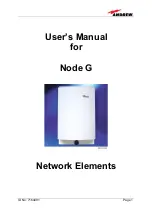
2 Introduction
ID No: 7164491
Page 13
2. INTRODUCTION
2.1. PURPOSE
Wireless communication systems provide a two-way information transfer (voice and
data) between a base station and multiple mobiles within a given area.
Environmental variables such as physical structures both man-made (buildings) and
natural (mountains) attenuate signals in the transmission path, which reduce the
transport signal’s strength. This attenuation leads to a reduction in quality and data
rate and eventually prohibits the system’s use entirely. A Node G is specifically
designed to extend coverage and to enhance quality.
In the downlink (DL), the Node G picks up signals coming from the base station,
filters them, amplifies them, and retransmits them to the mobile. In the uplink (UL), it
picks up signals from the mobile, filters them, amplifies them, and retransmits them to
the base station. The Node G constantly monitors the quality of the signals passing
through it, while simultaneously electronically decreasing isolation requirements.
2.2.
THE NODE G NETWORK ELEMENT
The Node G is more than a simple enhancer.
The unit is ideal for the first phase of the network rollout, and for any subsequent
phase where cost, coverage, and quality need to be optimized.
The Node G’s primary function is to increase signal strength between a mobile and a
base station in areas where high-quality voice or high-speed data service is not
available. This may include extending coverage areas such as small towns, shaped
coverage around man-made or natural obstacles, or extending a network beyond its
primary target areas. The unit is an excellent choice for any coverage area for urban
center to the rural highway.
From its power level to its setup, the Node G has intelligence and performance that
rival a base station.
The Node G is a self-diagnosing, self-adaptive, and virtually maintenance free.
Summary of Contents for Node G 930
Page 1: ...ID No 7164491 Page 1 User s Manual for Node G Network Elements ...
Page 12: ...User s Manual for Node G Network Elements Page 12 M0121A2A doc For your notes ...
Page 16: ...User s Manual for Node G Network Elements Page 16 M0121A2A doc For your notes ...
Page 28: ...User s Manual for Node G Network Elements Page 28 M0121A2A doc For your notes ...
Page 52: ...User s Manual for Node G Network Elements Page 52 M0121A2A doc For your notes ...
Page 56: ...User s Manual for Node G Network Elements Page 56 M0121A2A doc For your notes ...
Page 62: ...User s Manual for Node G Network Elements Page 62 M0121A2A doc For your notes ...














































